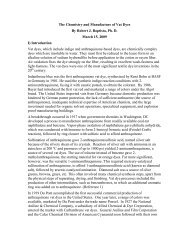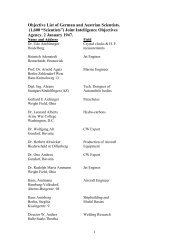International Dyestuff Industry - ColorantsHistory.Org
International Dyestuff Industry - ColorantsHistory.Org
International Dyestuff Industry - ColorantsHistory.Org
Create successful ePaper yourself
Turn your PDF publications into a flip-book with our unique Google optimized e-Paper software.
Figure 6. Apparatus for Separation of Product. Edelstein<br />
Collection, Hebrew University.<br />
The crude product of the sulfonation was diluted in large wooden tanks, a, the solution was<br />
brought to boiling by blowing steam into it, and wet slaked lime was added to bring about<br />
neutralization. (This operation was later carried out in wooden tubs fitted with mechanical<br />
stirrers.) The neutral mixture was then run into the vacuum filters, b, connected to iron<br />
reservoirs, dd, that were evacuated by means of an air pump. The mixture was filtered<br />
through successive layers of sand, pebbles, and bricks, covered by a coarse canvas<br />
stretched out on a wooden frame, such as c. One reservoir was connected so as to receive<br />
the concentrated filtrate and first washings; further washings with boiling water were drawn<br />
into a second reservoir. Some product remained mixed with the calcium sulfate in the filters<br />
and was extracted by removing the solid, boiling it with water, and returning the mixture to<br />
the filters.<br />
The salt solution in the first reservoir was concentrated “in iron pans heated either over a<br />
fire or by steam, until they contain about 15 per cent of lime salts. Soda crystals (sodic<br />
[sodium] carbonate) were then added in sufficient quantity to precipitate all the lime as<br />
carbonate, and thus to produce sodic salts of the sulpho acids. These were siphoned off<br />
from the carbonate of lime, and concentrated until they contained about 30 per cent of<br />
sodic salts.”<br />
These “sodic salts” were the sodium salts of the anthraquinonesulfonic acids, generally<br />
referred to as “soda salt,” or “silver salts.” At this stage in the alternative anthraquinone<br />
process, soda salts were prepared in a similar manner by the lime treatment. The salts<br />
were later found to be a mixture of two disulfonic acids and a monosulfonic acid, the<br />
proportions depending on which of the two methods was employed, and the amount of<br />
sulfuric acid added. Later, it was found possible to separate these salts from one another at<br />
this stage, “so that the different coloring matters they produce may be obtained in a more<br />
or less pure state.” However, it is unlikely that Perkin ever carried out such separations in<br />
his factory.<br />
The alkaline fusion was found troublesome to achieve on a large scale by both Perkin and<br />
Caro. The heating range had to be carefully maintained to prevent destruction of the<br />
product at high temperature. Laboratory experiments “were performed in an air bath, the<br />
products being heated in metallic dishes, a mixture of ‘soda salt’ [silver salt, the sodium<br />
salts of anthraquinonesulfonic acids] in a dry state with a saturated solution of the alkali<br />
being taken... and it was considered that caustic potash gave, on the small scale, the best





